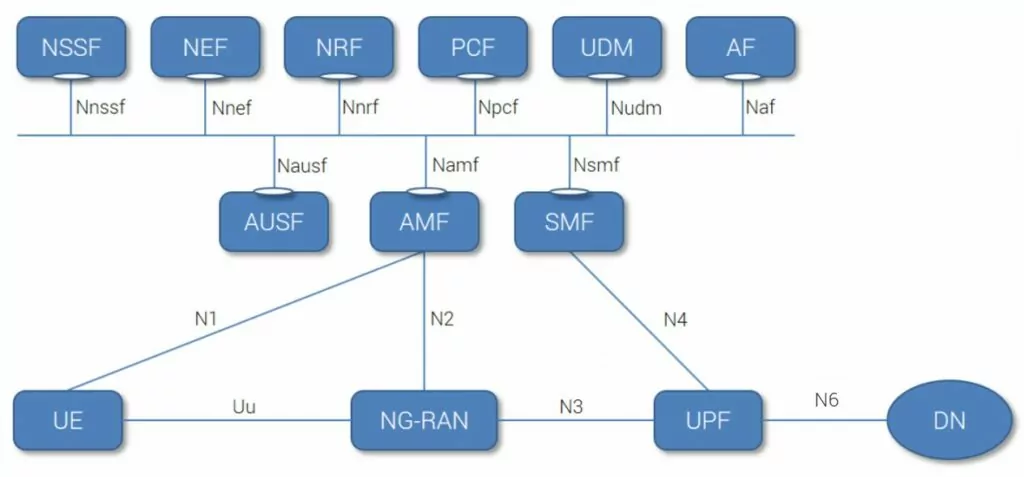5G Core Network Functions
Mục Lục
Introduction
As a follow-up from our previous post on 5G Core Network (5GC) and system architecture, today I’d like to touch upon the 5G network functions (NFs) that are related to the core network. As we’ll see, some of them look very similar to the corresponding functions in the previous generations’ core networks (CN). This of course is not surprising, as the network always has to carry out some basic functions such as: communicate with the UE, store its subscription and credentials, allow access to external networks & services, provide security and manage the network access and mobility. However, we will also see some new functions, that were not present before, which are needed to enable the new network paradigms like slicing and service-based networking.
Service-Based Architecture (SBA)
To describe the CN functions themselves, let’s first look at the system architecture from 3GPP SA2 in the following figure.

Figure 1: 5G System: Service-based architecture (SBA) [1]
We can see that part of this architecture, looks like good old LTE/3G with similar nodes and interfaces (lower part of the picture). However, the upper part of the figure (5GC Control Plane), has a “bus” and service-based interface exhibited by individual functions. This creates a so-called Service Based Architecture (SBA), in which, one CP network function (e.g. SMF) allows any other authorized NFs to access its services. According to [1], the NFs within 5GC Control Plane shall only use service-based-interfaces for their interactions.
Note: If you want to revisit the “good-old” reference point architecture representation for 5G, read our other blog on the general 5GC aspects: [5G CN Overview]. Yes, the 5G system architecture with reference points is still there.
Network Functions (NFs)
Ok, let’s discuss a bit of the 5GC network functions themselves and what functionalities they support (note that not all functionalities of individual functions are present). The main 5G NFs are the following:
- Access and Mobility Management Function (AMF) supports the Termination of NAS signaling, NAS ciphering & integrity protection, registration management, connection management, mobility management, access authentication and authorization, and security context management. (AMF has part of the MME functionality from the EPC world)
- Session Management Function (SMF) supports session management (session establishment, modification, release), UE IP address allocation & management, DHCP functions, termination of NAS signaling related to session management, DL data notification, traffic steering configuration for UPF for proper traffic routing. (SMF has part of the MME and PGW functionality from the EPC world)
- User plane function (UPF) supports: packet routing & forwarding, packet inspection, QoS handling, acts as an external PDU session point of interconnecting to Data Network (DN), and is an anchor point for intra- & inter-RAT mobility. (UPF has part of the SGW & PGW functionality from the EPC world)
- Policy Control Function (PCF) supports a unified policy framework, providing policy rules to CP functions, and access to subscription information for policy decisions in UDR. (PCF has part of the PCRF functionality from the EPC world)
- Authentication Server Function (AUSF) acts as an authentication server. (part of HSS from EPC world)
- Unified Data Management (UDM) supports the generation of Authentication and Key Agreement (AKA) credentials, user identification handling, access authorization, and subscription management. (part of HSS functionality from EPC world)
- Application Function (AF) supports: application influence on traffic routing, accessing NEF, and interaction with a policy framework for policy control. (same as AF in the EPC world)
- Network Exposure Function (NEF) supports exposure of capabilities and events, secure provision of information from external applications to the 3GPP network, and translation of internal/external information. (not present in the EPC world)
- NF Repository function (NRF) supports: service discovery function, maintains NF profile and available NF instances. (not present in the EPC world)
- Network Slice Selection Function (NSSF) supports: selecting the Network Slice instances to serve the UE, determining the allowed NSSAI, and determining the AMF set to be used to serve the UE. (not present in the EPC world)
Summary
As we can see from the description of the individual NFs, some of them are modified, split, or merged versions of the good old EPC functions (like MME, SGW, PGW, HSS & PCRF) namely, AMF, SMF, PCF, UDM, AF, UPF or AUSF, but unlike EPC functions, AMF, SMF, and UPF should be access independent.
On the other hand, there are some functions that are new, related either to the concept of slicing (i.e., NSSF), to support handling multiple slices, or to the SBA itself (i.e., NEF & NRF) to support the concept of services subscription, exposure, and access.
Another thing is that in this architecture, we have a full CP & UP split in the core network, i.e. UPF supports UP data processing, while all other nodes act as CP functions (this is a bit different compared to EPC, where, e.g. PGW was acting a bit as UP and CP node, having some DHCP functionality and IP address allocation and PCEF functionality). This allows for independent scaling of CP and UP functions for the operators and for handling network slices efficiently to tailor them to support different services.
References/resources
[1] 3GPP TS 23.501 V15.0.0 (2017-12) System Architecture for the 5G System (Stage 2)
[2] https://academy.5g-courses.com/courses/towards-5g-online-course















![Toni Kroos là ai? [ sự thật về tiểu sử đầy đủ Toni Kroos ]](https://evbn.org/wp-content/uploads/New-Project-6635-1671934592.jpg)


